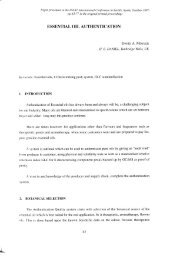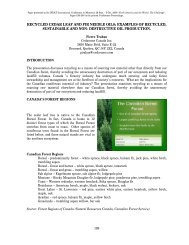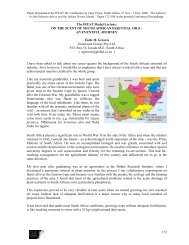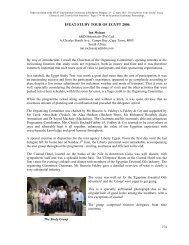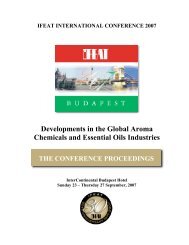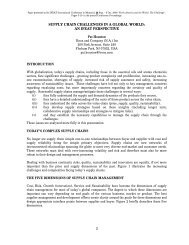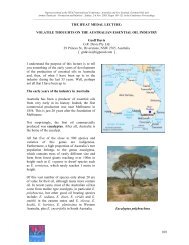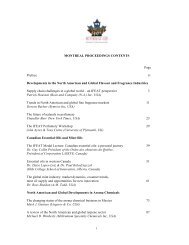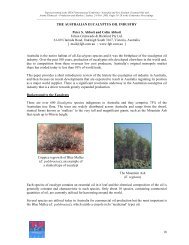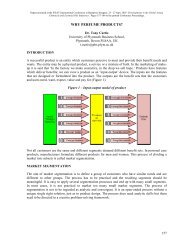developing supplier-customer relationships with special ... - IFEAT
developing supplier-customer relationships with special ... - IFEAT
developing supplier-customer relationships with special ... - IFEAT
- No tags were found...
You also want an ePaper? Increase the reach of your titles
YUMPU automatically turns print PDFs into web optimized ePapers that Google loves.
Paper presented at the <strong>IFEAT</strong> International Conference in Lisbon, Portugal, October 2004.Pages 166–169 in the printed Conference Proceedings.DEVELOPING SUPPLIER-CUSTOMER RELATIONSHIPS WITHSPECIAL REFERENCE TO QUALITY EXPECTATIONSDr. George HarveyProcter & Gamble Inc., 5289 Vine St., Cincinatti, Ohio 45217, USA[ harvey.g@pg.com ]In today’s competitive global market place, domestic consumers demand a very high standard andconsistency in the quality of consumer products offered by the major manufacturers. Moreover, thereis the expectation that a particular branded product does not differ in quality wherever the product ispurchased in the world. This requirement has led all of the major consumer products manufacturers toadopt stringent quality control in their manufacturing processes and it has had a knock-on effect intheir criteria for appraisal of the quality of ingredients purchased from <strong>supplier</strong>s. Consequently, a highawareness of quality is imperative in the entire supply chain from the primary producer of ingredientsthrough to the consumer product manufacturer.This presentation discusses:• quality control and quality assurance in relation to perfume ingredients from the viewpointof a major consumer product manufacturer, and• the need by all parties in the supply chain to develop a better understanding of the issuesand for a collaborative effort in meeting the challenges.My qualification to speak on these topics is that of a scientist responsible for ingredient quality controland assurance in a major consumer products manufacturing company.Quality evaluation: a perspectiveWhen I joined the industry as an analytical chemist in 1970, the analysis of essential oils involvedusing the classical techniques of measuring optical rotation, refractive index, specific gravity and thecustomary titrimetric techniques. Chemists quickly realized that extremely valuable information mightbe gained by the use of a new and novel technique called gas chromatography (GC). Although thistechnique was still in its infancy stage, we were able to develop methodology for many of the essentialoils and some other raw materials purchased. The later coupling of gas chromatography <strong>with</strong> massspectrometry (GC/MS) permitted the determination of compositional specifications. Most of thesespecifications were generated <strong>with</strong>out <strong>supplier</strong> input. These compositional specifications, whencomplemented <strong>with</strong> data from the classical techniques, insured the consistent quality needed by thecompany.Perfumes play a major role in the success of many consumer products and natural essential oils play amajor role in perfumes. Considering that product odour is a one of the major attributes for consumeracceptance, it is critical that products maintain a high degree of quality and consistency. Thisrequirement has led all major consumer product manufacturers to adopt stringent quality control intheir manufacturing processes. It also has had an add-on effect in their criteria for appraisal of thequality of ingredients purchased from <strong>supplier</strong>s.Ever increasing demands are being placed on consumer product manufacturing companies around theworld by governmental regulations, human safety and environmental concerns, etc. These pressureshave made it very clear that a strong quality assurance/quality control program was vitally important166
for marketing safe and high quality products. Consequently, a high awareness of quality is imperativein the entire supply chain from the primary producer of ingredients through to the consumer productmanufacturer.In my early days in the industry, the term ‘global’ did not have quite the same meaning or importanceas it does today. My company’s primary concern then was that products manufactured anywhere in theUSA were of the same quality. The same held true for our products manufactured in other countries.In today’s competitive global market place, consumers demand a very high standard and consistencyin the quality of consumer products offered by the major manufacturers. Moreover, there is theexpectation that a particular branded product does not differ in quality wherever the product ismanufactured or purchased, whether it be in North America, South America, Europe, Asia or Africa.During the course of reviewing more than 4,000 specifications my own company, Procter & Gamble(P&G) had developed over the years, I would venture to say that >25% of the specifications wereeither wrong, ambiguous or impossible to meet consistently. Unfortunately, the <strong>supplier</strong>s also knewthis but had no choice but to accept them and on occasion ignore them, knowing that the buyer did nothave sufficient quality systems in place at the manufacturing sites to detect adulterations, dilutions etc.It was found also that there were many different qualities of the same natural essential oil being usedregionally. In many cases, the current specifications were not correct or realistic. In some cases the<strong>supplier</strong>’s internal specifications were not correct or too broad.In my initial contacts <strong>with</strong> our <strong>supplier</strong>s, I tried to emphasize that my position was to be as an‘informed’ partner in discussions rather than a <strong>customer</strong> trying to impose demands. When working<strong>with</strong> <strong>supplier</strong>s, I try to take the position that they know their products better than we do and as such arereally the ‘experts’. Only when we have historical data to support a particular position do we stronglysuggest acceptance of our proposal.There were two significant learning’s from these initial contacts. The first and probably mostimportant point for the longer-term was the receptiveness of many <strong>supplier</strong>s to freely and honestlydiscuss their products when they are treated as an equal partner and are recognized as knowledgeableexperts on the materials they produce and supply. Secondly, and also very important, is that the<strong>supplier</strong> knows and has agreed to the expected quality of a natural that our company will be using inour global products and perfumes. In the past, a ‘natural’ supplied in Europe could have been (andoften was) of a different quality than the same ‘natural’ from the same <strong>supplier</strong> that was supplied tothe USA.Evolution and developmentOver the years, we have worked very closely <strong>with</strong> <strong>supplier</strong>s on <strong>developing</strong> realistic globalspecifications. This does not necessarily say that these specifications are etched in stone sinceanalytical and olfactory techniques are constantly evolving. If you – as a <strong>supplier</strong> - consider that thereare certain analytical specifications that are unnecessary, too broad, too restrictive or do not adequatelyreflect the true quality in relation to the price, then this is open to discussion. We will be glad toevaluate our historical data and discuss these concerns <strong>with</strong> our other long-term and trusted <strong>supplier</strong>s.Having global specifications insures that the same quality of naturals will be supplied to all of thecompany’s manufacturing sites and technical centres. I cannot stress enough how important thisapproach is to our on-going effort in this area.167
My company and other large consumer product manufacturers set high expectations today for<strong>supplier</strong>s. The converse should also be true. Setting, understanding and meeting these expectationsideally would be a collaborative effort between the buyer and <strong>supplier</strong>s, <strong>with</strong> the realization that each<strong>supplier</strong> has different needs, limitations and capabilities.The net result should be that the buyer receives consistent high quality for its investment, which is thesame expectation that our <strong>customer</strong>s have.To illustrate the desired situation, I will take as an example the procedures that our company, P&G hasput in place for <strong>developing</strong> a <strong>supplier</strong>.Obviously the first step for a <strong>supplier</strong> is to contact the perfume-purchasing group. Let me emphasizethat I am not in the purchasing organization but have the role of Senior Scientist <strong>with</strong> responsibility forstandardization. If the price for the material is competitive, the potential <strong>customer</strong> is informed of thecurrent specifications for that material. Our specifications include gas chromatography (whereapplicable), refractive index at 20˚C, specific gravity at 25˚C, odour, colour and appearancemeasurements and evaluations. All of our manufacturing sites currently run the same methods.Then we will supply you <strong>with</strong> a ‘target’ standard sample that currently meets all of our specifications.If you determine that your product can meet these specifications, then we would request that yousupply us <strong>with</strong> 50g samples from each of three lots that represent your global production. What I meanby this is that if you intend to supply the material from more than one manufacturing site, we needrepresentative samples from each of those sites. We fully expect that you would have one set ofspecifications for each product. It is unacceptable that your material would have differingspecifications based on where the material is produced. The documents that need to accompany thesamples include a certificate of analysis, your current global specifications, MSDS sheets and a listingof all of your manufacturing sites. Omission of any of these documents will lead to an unnecessary andpotential lengthy delay of your qualification.Our naturals perfume group subjects each submission to an odour evaluation. If the sample receives anodour grade of at least a ‘B’ (based on A, B, C, D grading system), the additional analytical testswould be performed.If one or more of the submissions fail to meet all of the specifications, you will be notified as to whyand additional samples will be requested. If each of the submissions passes all the testing, thepurchasing group is informed that they may proceed <strong>with</strong> contract discussions. Each approved <strong>supplier</strong>is continually evaluated for meeting both delivery and quality expectations. This does includesupplying a certificate of analysis and a MSDS sheet <strong>with</strong> each shipment.I know as well as you that there will be circumstances and situations that arise that are out of eitheryour or our control. Since neither party can control the environment or climate, we need to besomewhat flexible. I need to stress that it is imperative that you make notification prior to shipment, ifthe material is not going to meet the current specifications. You can contact either your purchasingcontact or myself. This will save valuable time and reduce unnecessary cost for both parties. We canthen discuss and evaluate the situation. We have procedures in place that will allow for the acceptanceof a material if the reason(s) is understandable and beyond anyone’s control and does not impactproduct quality. Our manufacturing sites then can be alerted as to why an out of specification materialis coming and thus prevent them from an unnecessary rejection. However if the material failedbecause of odour, there probably is very little we can do and the lot would be rejected. I cannot168



